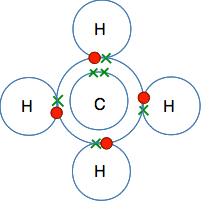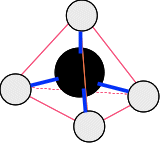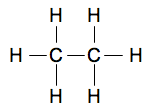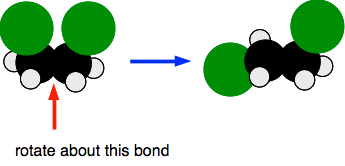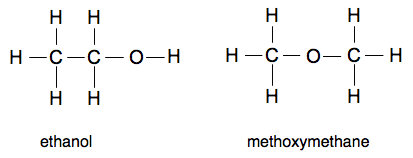|
Chemguide: Core Chemistry 14 - 16 Ways of representing organic compounds on paper Organic chemistry is the chemistry of carbon-based compounds other than the most simple ones like carbon dioxide and carbonates. When you start organic chemistry it can be quite confusing. On this page we are just going to look at the various ways organic formulae can be written and organic structures drawn. You will need a simple knowledge of covalent bonding. Some of you might find a lot of what is on this page obvious, but others won't - so I'm not apologising for taking this very gently! Ways of drawing simple organic molecules Background A hydrocarbon is a compound of hydrogen and carbon only. The simplest one (in fact the simplest organic compound) is methane, CH4. If you draw a dots-and-crosses picture of its bonding, it looks like this:
We often simplify these covalent diagrams by just drawing straight lines to represent a shared pair of electrons. So we can show the covalent bonding in methane as:
And that's how organic compounds are often drawn. If you draw all the bonds in this way, it is known as a fully displayed structure. But this is slightly misleading. There is a hidden problem which could cause you difficulties in the future if you don't recognise it now. It looks as if all the bonds in methane are at right angles to each other, all lying in the same plane. That's simply not the case. If you made a model of a methane molecule, it would look like this:
The arrangement of the hydrogens around the carbon is said to be tetrahedral. A tetrahedron is a triangularly based pyramid. You can think of the carbon atom being at the centre of the pyramid with a hydrogen atom on each corner.
All of the angles between the bonds in methane are exactly the same - and are approximately 109.5°. The bonds take up this shape so that the electron pairs in the bonds get as far apart from each other as possible. Now let's look at a slightly bigger molecule, ethane. The molecular formula for ethane is C2H6. The molecular formula is simply a count of all the atoms in a molecule of the compound. The atoms in ethane are arranged like this:
Now suppose you replaced one of the hydrogens by a chlorine to give the compound C2H5Cl. Here are two apparently different ways you could do this - with the chlorine at the end of the molecule or at right angles to it.
But if you look at a models of the molecules, that simply isn't true! Here is ethane:
If you look at the hydrogens at the right-hand end of the model, they are all in equivalent positions. Suppose you attached a chlorine to one of those positions:
If you made a model of this, you could just turn it around a bit to make the chlorine appear in any of those positions. And if you flipped it over, you could equally well make it appear in any of the positions on the left-hand carbon. There is only one compound C2H5Cl. We would normally draw the chlorine on the right-hand end, but it actually doesn't matter. Let's complicate this a bit more, by replacing one of the hydrogens on both carbons by a chlorine. Are these two different molecules?
Here are the models:
If you have a single bond between carbon atoms, the molecule can rotate around that bond. The two ends can move relative to each other. A small rotation will change one of the models above to the other one. So they are the same molecule.
Molecular formulae We have already met these. They simply give a count of the number of each sort of atom in the molecule. In organic chemistry, they aren't used very often, because what governs the chemistry of a compound is the way the various atoms are joined up. To take a simple example, ethanol (ordinary alcohol) has a molecular formula of C2H6O. But that doesn't tell you anything about the important part of the molecule which is an OH group. In fact there is another compound with that same molecular formula with completely different bonding.
| |
|
Note: You will need to know about ethanol at this level, but not methoxymethane. I'm including it just to show that the molecular formula doesn't usually give enough information. | |
|
Fully displayed structural formulae These are the line diagrams we have used above. They give you all the details of the bonding and arrangement of the atoms in the molecules. But . . . for anything other than the simplest of molecules, they are a real bother to draw and much of the detail is unnecessary. So we simplify them. Structural formulae In the case of ethanol above, what really matters is that there is an OH group attached at the end of a hydrocarbon chain. Without losing any essential information, we can simplify the molecule as CH3CH2OH That is quick to write, and says everything important about the structure. Similarly, we could write the structural formula for a relative of ethanol (in this case, butan-1-ol - don't worry about the name for the moment) as CH3CH2CH2CH2OH . . . and because the essential structure is the same, you would expect it to have similar properties. Sometimes we draw a structure which is a mixture of a simple structural formula and a displayed formula if it helps to make something clearer. For example, ethanoic acid (old name acetic acid) has a molecular formula C2H4O2. We often draw the structural formula as CH3COOH . . . but this is a bit vague about what is going on in the COOH group. So we quite often draw that bit fully displayed.
Empirical formulae I am including this so that you have heard of it, but it isn't a useful type of formula in organic chemistry. "Empirical" means "from experiment". For example, it is possible to do an experiment with ethane which shows that there are 3 hydrogens for each carbon atom - CH3. That's the empirical formula - it is simply a ratio. The molecular formula is, of course, C2H6. You will come across empirical formulae again when you start to do some chemistry calculations. This is much more important in inorganic chemistry - the sort of chemistry you have been doing up to now.
© Jim Clark 2021 |
|
